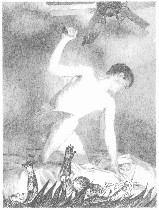 Two must sees at Gallery Joe–Annabel Daou’s “ideas about the thing and the thing itself” and Rob Matthews’ “The Assumption.” The Matthews work is in the vault and out front, the work from Daou (right, Rob Matthews saving himself from from evil).
Two must sees at Gallery Joe–Annabel Daou’s “ideas about the thing and the thing itself” and Rob Matthews’ “The Assumption.” The Matthews work is in the vault and out front, the work from Daou (right, Rob Matthews saving himself from from evil).I already had some idea of what Rob Matthews would show. The clever guy sent along an invitation to his show wrapped in an envelope printed with biblical text, along with a CD of his drawings. I wondered if the CD was his way of suggesting that my fly-by-day photos left something to be desired. Or perhaps he was just being helpful and doing his best to make sure I went to the show.
Well, I wouldn’t have missed this show for the world. Matthews’ small pencil drawings, their precise, delicate hatch marks building up to create an almost photographic image, are superb, as ever. These new ones, loaded with religion and art history, are also loaded with Matthews and his life and his worries.
Channeling William Blake and every assumption painting you can imagine, Matthews depicts his life, beset by shadowy devils in the dining room, burning devils writhing around his bed, and snakes in hand or in mouth. He’s from the South, so maybe this doesn’t seem as weird to him as it seems to me. But the work is seductive and funny.
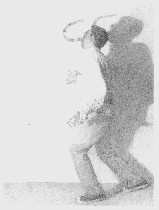
I am especially amused that a guy with a snake in his mouth could be wearing Converse sneakers (left), and by the notion of beating back the forces of evil with a claw hammer. There’s also the humor Matthews in his shorts on the tousled bed, compressed between a very low ceiling fan above and hell itself below, his shadow looming behind him.
Then there’s suburbia, part of an altar with five panels, Matthews himself and his wife, Tracy, holding a cat, standing in the folding side panels like attending saints. Above suburbia is the sky, below it is more tousled sheets, but these bring to mind the drapery of a pieta as well as sleepless nights.
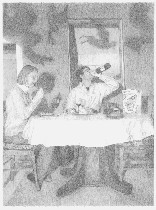 The CD images had seduced me into thinking I had already seen this work. However, once I was there at the real exhibit, the paper, the fine texture of the pencil marks transformed what had been just a digital picture on my computer into something solid. The concentrated, repetitive marks become a physical presence, an exclamation of monk-like intensity and religious practice.
The CD images had seduced me into thinking I had already seen this work. However, once I was there at the real exhibit, the paper, the fine texture of the pencil marks transformed what had been just a digital picture on my computer into something solid. The concentrated, repetitive marks become a physical presence, an exclamation of monk-like intensity and religious practice.
Part of what I admire about Matthews’ work, besides the flat-out skill, is the cinematic, horror-movie frisson, and the story-telling ambiguity. I like the self-portraiture, which gives the stories even more resonance. These images speak with affection, humor and dread–of religion, of wrestling with personal demons, of the apartment and its dark corners as a shadowy pressure cooker of daily life (right, Rob and Tracy Matthews at the table).
War games
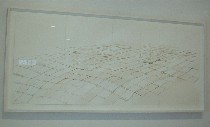 Out front, Annabel Daou’s drawings and sculptures took my breath away and broke my heart. The exhibit includes a number of large, loose, pencil drawings on multiple sheets of paper. The images are house-of-cards landscapes, shaky cube walls that can topple in a breeze and unsteady terrains of stacked paper or books with little carpets suggesting just which spot is best for stepping down into the abyss or onto the next shaky level. Pieces are cut out of the paper sometimes, emphasizing the flimsy crust upon which she draws and upon which we step (left, “Position”).
Out front, Annabel Daou’s drawings and sculptures took my breath away and broke my heart. The exhibit includes a number of large, loose, pencil drawings on multiple sheets of paper. The images are house-of-cards landscapes, shaky cube walls that can topple in a breeze and unsteady terrains of stacked paper or books with little carpets suggesting just which spot is best for stepping down into the abyss or onto the next shaky level. Pieces are cut out of the paper sometimes, emphasizing the flimsy crust upon which she draws and upon which we step (left, “Position”).daou, annabel
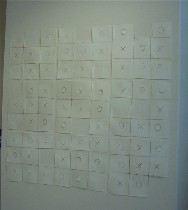 A number of pieces are about games–a tic tac toe game missing squares (right); a deck of cards almost but not quite real; a wooden deck, all suits black; a chessboard that only appears to support the pieces. They’re games of life and survival, and they take the Minimalist grid right out of the factory and give it some juice (image left below, “Anton’s Delusion,” named for a medical condition in which blind people believe they can see and create their own reality).
A number of pieces are about games–a tic tac toe game missing squares (right); a deck of cards almost but not quite real; a wooden deck, all suits black; a chessboard that only appears to support the pieces. They’re games of life and survival, and they take the Minimalist grid right out of the factory and give it some juice (image left below, “Anton’s Delusion,” named for a medical condition in which blind people believe they can see and create their own reality).
My favorite text piece was “directions for the loss of meaning,” in which rules of war are transliterated from English into Arabic script. Some of the words are re-transliterated back into English–“rules of war,” “technicalities,” “to complete the war you lose,” “So the war must continue.” It’s about war, war games, and life. Using the same transliteration trick of English words into Arabic script in “a foreign song,” Daou writes all the nursery rhymes she knows, and then cuts out some of the lines. So much gets lost in translation between cultures that do not understand one another. Gallery owner Becky Kerlin mentioned that Daou was born in Lebanon in 1967 to a Lebanese mother and an American father. She left Lebanon for the United States at age 18, leaving her family behind.
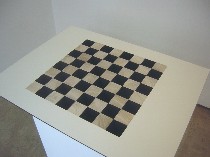
Daou works between the world of symbols and images and the world of text. And as a paper artist, cutting through the surface, she uses the paper as a material, not just as a surface. In her 3-D work (well it’s all 3-D in some sense), she’s a bit of a jokester. She pulls all of this off, drawing parables about human condition in a political world. There’s a lot happening in this work, which on the surface seems so simple.









